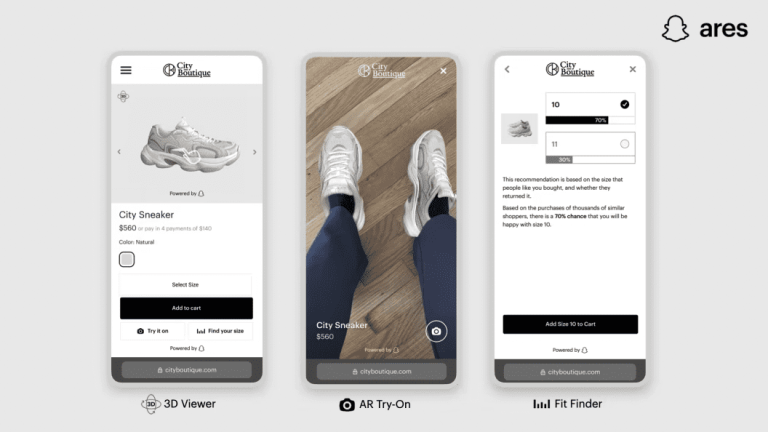As brands and retailers look to convert more customers, they’re also looking to increase customer confidence during checkout to keep returns down, especially as shipping costs skyrocket.
To check all those boxes, brands and retailers are considering solutions that offer customers an immersive and interactive shopping experience to help them better understand what they can expect from the product. Augmented reality (AR) is one such solution that is helping brands and retailers do just that.
Facilitating the adoption of AR commerce is Snap, the parent company of Snapchat, which has invested in AR for over 10 years and has rolled out a Shopping Suite that features a set of try-on and sizing tools specifically geared toward retail in clothing, footwear and eyewear.
“Over the last decade, we’ve been hard at work bringing fun and personal AR experiences to Snapchatters,” said Jill Popelka, head of AR enterprise services at Snap, in a Thursday (March 23) press release. “In the next decade, we’re excited to take our world-class AR technology to businesses’ websites, apps and even into their physical locations. We look forward to making the shopping experience more delightful for consumers and transforming businesses around the world with AR Enterprise Services.”
The company said in a separate press release that more than 250 million users engage with AR on Snapchat every day.
How AR Can Help Retailers
Advertisement: Scroll to Continue
AR technology provides a way for retailers to enhance the shopping experience for their customers by adding virtual elements to the physical world. The technology can be used to help customers visualize products in their own environments before making a purchase, providing a more immersive and interactive shopping experience.
It can also increase engagement as AR experiences can be entertaining and engaging for customers, which can increase their likelihood of making a purchase and returning to the store. Furthermore, AR can help retailers create a more personalized and interactive shopping experience, which can help build customer loyalty and reduce returns.
How Snap’s Shopping Suite Works
AR Enterprise Services’ (ARES’s) debut product, Shopping Suite, comprises several features that clients can access by paying a standard startup fee and additional charges. The first feature, AR Try-On, provides customers with a live interactive experience using a filter or uploaded photo to virtually “try on” products like sunglasses or shirts. The second feature, 3D Viewer, enables customers to view products like shoes from multiple angles. The third feature, Fit & Sizing, uses artificial intelligence (AI) to suggest the best size of clothing or footwear for each customer based on data collected.
The core of these features is the Enterprise Manager, a customized back-end system that allows retailers to input their entire product catalog, including product descriptions, size charts and images. Snap’s AR tools will then use this data to support the other three functions. For instance, after a retailer uploads product information and photos of a bag, Snap can generate a 3D image of the bag and integrate it into the 3D Viewer. Snap can also use images of people with different body types to display photos of a dress in the AR Try-On feature, eliminating the need for a lengthy photography shoot with multiple models.
Snap’s goal is to increase the likelihood of customers completing a purchase by offering them the ability to “try on” products in various colors and styles, providing a more realistic representation of the product, and using personalized sizing recommendations. By doing so, Snap aims to address significant challenges faced by businesses through its Shopping Suite.
Who’s Using AR Today
Companies such as Apple and IKEA have already used AR to allow shoppers to visualize how products would look in their homes, Modern Retail reported. Additionally, companies like Ray-Ban and Nike have adopted virtual try-on technology to enhance sales. Virtual fitting rooms have also gained popularity in recent years.
Several retailers, including Prada and American Eagle, have used Snap’s AR tools to enable customers to “try on” and buy products like sneakers and sunglasses. Nevertheless, most of the process has previously taken place within the Snapchat app. Through ARES, retailers can now incorporate the same tools into their websites and product pages, providing them with greater control over the shopping experience and user data.
Snap has also been collaborating with multiple retailers, including Princess Polly, Gobi Cashmere and Goodr sunglasses, over the previous three to six months to test features for ARES and Shopping Suite, although the company has decided to reveal these offerings now.
According to Snap, Goodr observed a 67% increase in conversion for mobile users who used the AR Try-On feature, while Princess Polly had a 24% lower return rate for customers who used the Fit & Sizing recommendation tool. Snap recognizes that implementing AI and AR tools can be expensive, and it aims to make the technology more accessible to retailers. Carolina Arguelles, Snap’s head of AR enterprise product strategy and product marketing, told Modern Retail that Snap’s focus has not only been on creating high-quality, realistic experiences, but also on making the process efficient and easy for retailers to integrate.
For all PYMNTS retail coverage, subscribe to the daily Retail Newsletter.




